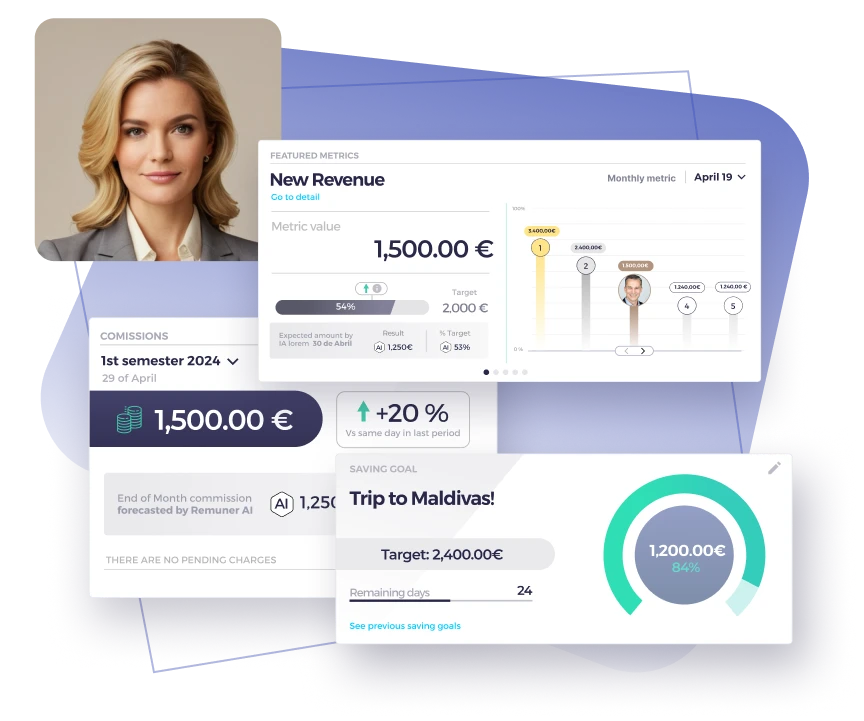Table of contents
What is an incentive?
An incentive it’s a reward offered to encourage employees to reach or exceed specific performance benchmarks. Incentives play a fundamental role in driving employee motivation and achieving business goals.
Incentives come in various forms, tailored to help employees perform at their best, align their efforts with organizational goals, and maximize overall sales performance. By creating a connection between effort and outcomes, companies can foster high-performing teams and achieve long-term success.
4 Real-World Examples of Effective Incentive Programs
To implement an effective reward strategy, it’s essential to understand the different types of benefits available. Here are the most common ones used in sales compensation:
- Monetary incentives:
Cash bonuses, commissions, and profit-sharing programs fall under this category. For instance, a salesperson may earn a commission for every sale they close, which directly incentivizes them to sell more. Financial incentives like these drive immediate results and are often part of compensation plans. - Non-monetary incentives:
These rewards go beyond cash and include perks like additional vacation days, flexible working hours, or training opportunities. Offering stock options, for example, aligns employees with the company’s long-term growth and success. - Recognition-based incentives:
Public recognition or awards are cost-effective ways to motivate employees. When incentives are offered in the form of acknowledgment, it builds morale and encourages others to strive for similar achievements. - Team-based incentives:
Collaboration can be incentivized by offering rewards for collective success. For example, if a sales team exceeds their quarterly quota, they might enjoy a group bonus or an all-expenses-paid team outing. - Tax-efficient benefits:
Some incentives, like contributions to retirement funds or healthcare benefits, can reduce an employee’s tax liability while improving their overall compensation package. These long-term incentives foster loyalty and retention.
How incentives impact sales performance
Rewards align employee efforts with organizational objectives. When structured effectively, they drive several key outcomes:
- Motivating employees to exceed expectations:
With clearly defined rewards, employees feel inspired to work harder. For example, a salesperson with a quarterly bonus tied to their quota will likely push harder to achieve their targets. - Fostering long-term commitment:
Benefits like stock options encourage employees to stay with the company and contribute to its growth. This alignment leads to a shared vision of success. - Improving morale and competition:
Friendly competition among team members, driven by recognition or performance-based bonuses, can boost overall productivity.
Examples of effective rewards in action
1. Using financial rewards to meet quotas
A sales manager might set a $5,000 bonus for employees who exceed their quarterly sales quota. This motivates employees to put in extra effort and aim beyond the minimum target.
2. Recognizing high performers
A company rewards the top-performing salesperson each month with a public award and a gift card. This type of recognition builds morale and encourages others to strive for excellence.
3. Long-term retention strategies
A tech company provides stock options to employees who remain with the company for five years. This ties individual success to the organization’s financial health, fostering loyalty.
4. Team-based rewards for collaboration
A sales team that exceeds its collective quota receives an all-expenses-paid weekend retreat. This approach encourages teamwork and collective success.

Designing effective compensation plans with incentives
Creating a successful reward program requires careful planning and alignment with company goals. Below are steps to ensure rewards are effective:
- Define measurable objectives:
Set clear targets for employees, such as achieving specific sales quotas or improving customer satisfaction. Employees perform best when they understand the rewards tied to their efforts. - Balance short-term and long-term rewards:
While monetary rewards like cash bonuses drive immediate results, non-monetary benefits such as stock options encourage employees to remain invested in the company’s long-term growth. - Use transparency to build trust:
Employees need real-time visibility into their progress and rewards. Clear communication ensures they understand how their efforts contribute to their compensation. - Offer a mix of rewards:
Combining financial and recognition-based rewards with tax-efficient benefits ensures a holistic approach that appeals to a diverse workforce.
Why incentives matter?
Rewards are strategic tools to motivate employees, improve performance, and drive organizational success. Beyond simply recognizing hard work, they create a culture of accountability and high performance by aligning employee goals with company objectives.
For sales teams, effective rewards—whether monetary, non-monetary, or recognition-based—can drive measurable results. For organizations, well-designed programs are a cost-effective way to boost productivity, retain top talent, and foster long-term growth.
Understanding what is incentive and leveraging it effectively can transform not only how employees view their roles but also how they contribute to broader business goals. By offering the right mix of rewards, companies can unlock the full potential of their workforce and secure lasting success.
FAQs about incentives
What is an incentive in the workplace?
An incentive is a reward designed to motivate employees to achieve specific goals or exceed performance benchmarks. These rewards can be monetary (e.g., commissions, bonuses), non-monetary (e.g., extra vacation days, flexible work hours), or recognition-based (e.g., public acknowledgment, awards).
How do incentives impact employee performance?
Incentives directly influence motivation, productivity, and engagement. Well-structured rewards encourage employees to work harder, align their efforts with company objectives, and contribute to a positive, high-performance work culture.
What are the most effective types of incentives for sales teams?
The best incentives for sales teams typically include monetary rewards (commissions, bonuses), non-monetary benefits (stock options, training opportunities), and team-based rewards (group bonuses, company-paid retreats). The key is to balance short-term motivation with long-term retention strategies.
What is the difference between financial and non-financial incentives?
Financial incentives involve direct monetary rewards such as salary increases, cash bonuses, and commissions. Non-financial incentives include career growth opportunities, flexible work arrangements, and public recognition. Both play a critical role in driving employee motivation.
How can companies create an effective incentive program?
To build a successful incentive program, companies should:
- Set clear, measurable goals tied to performance.
- Offer a mix of rewards (monetary, non-monetary, and recognition-based).
- Ensure transparency so employees understand their earnings and incentives.
- Align incentives with company objectives to drive long-term growth and employee retention.





